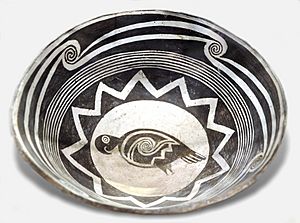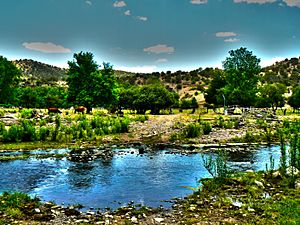Mimbres River facts for kids
The Mimbres River is about 91 miles (146 km) long. It flows through southwestern New Mexico. This river starts from snow and rain on the southwestern slopes of the Black Range mountains. It then flows south into a special type of basin called an endorheic basin. This means the river water doesn't reach the ocean. Instead, it sinks into the ground in the desert near Deming. Even though the surface water disappears, the riverbed and underground flow continue.
The land around the upper part of the river is managed by the US Forest Service. Most of the land in the Mimbres Valley is privately owned. The Mimbres River area covers about 5,140 square miles (13,000 km²). It even stretches a little bit into northern Chihuahua, Mexico.
Protecting the Mimbres River
Many different kinds of animals live in and around the Mimbres River. Scientists are very concerned about protecting 37 species, including various fish, birds, and mammals. Almost half of these species (18 of them) are considered "vulnerable," "imperiled," or "critically imperiled." This means they are at risk of disappearing in New Mexico or even across the country.
Thirteen other species are also at risk in New Mexico, even if they are doing better in other parts of the country. Birds, mammals, amphibians, and reptiles are all important to protect in the river areas and nearby lands.
People still discuss how the water from the Mimbres River should be used. This shows how important the river is to everyone.
The Ancient Mimbres Culture

The Mimbres River area was once home to an ancient group of people called the Mimbres Culture. They were part of a larger group known as the Mogollon culture. This culture lived here from about 200 to 1000 CE.
During this time, the Mimbres people started using more pottery. They also began to rely more on farming. Their farming depended a lot on water from the Mimbres River, both from its constant flow and from storm runoff.
Later, the Mimbres people started making very detailed and beautiful pottery. This pottery often had black designs on a white background. Their villages and farming systems grew larger. They also built big community buildings called kivas. Around 900 CE, these large kivas were burned in special ceremonies. This marked a big change in how the Mimbres people lived and practiced their rituals.


